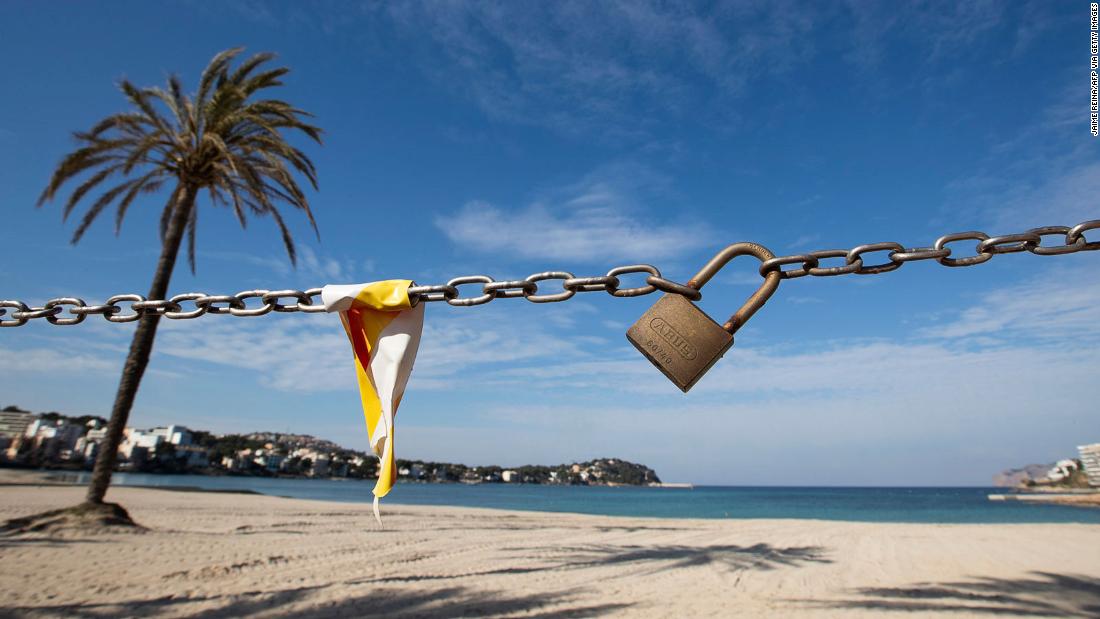Products You May Like
Earlier this month, the European Union unveiled an action plan to reopen its internal borders in time for summer, while countries such as Estonia, Latvia and Lithuania have formed “travel bubbles,” lifting restrictions for each other’s citizens.
A number of Caribbean islands are preparing to open their doors to foreign visitors in June, while destinations such as Mexico and Thailand are planning to open up again region by region in the coming weeks.
If you’re one of many travelers eagerly awaiting news on where you can travel to this year, here’s a guide to the top destinations making plans to reopen, as well as some of those that are keeping their borders firmly closed for now.
Cyprus

Cyprus has pledged to cover holiday costs for Covid-19-positive tourists and their families.
Courtesy Cyprus Tourism Organisation
Cyprus is so keen to get its tourism industry back on track, officials are offering to cover the costs of any travelers who test positive for Covid-19 while on vacation in the Mediterranean island nation.
According to a letter shared with CNN, the Cypriot government will pay for lodging, as well as food, drink and medication for tourists who are taken ill with coronavirus during their visit.
The detailed plan was set out in a five-page letter issued to governments, airlines and tour operators on May 26.
Officials have also earmarked a 100-bed hospital for foreign travelers who test positive, while a 500-room “quarantine hotel” will be available to patients’ family and “close contacts.”
“The traveler will only need to bear the cost of their airport transfer and repatriation flight, in collaboration with their agent and/or airline,” states the letter.
The news came shortly after Cyprus Transport Minister Yiannis Karousos announced hotels in the country will reopen on June 1, while international air travel will restart on June 9.
Once the destination reopens, visitors from only chosen countries will be allowed to enter.
Incoming flights from Greece, Malta, Bulgaria, Norway, Austria, Finland, Slovenia, Hungary, Israel, Denmark, Germany, Slovakia and Lithuania will be authorized first.
From June 20, Cyprus will also permit incoming flights from Switzerland, Poland, Romania, Croatia, Estonia and the Czech Republic.
However, the list is to be expanded to include furthe23r countries in the coming months.
Travelers heading to Cyprus will need to provide a valid certificate proving they’ve tested negative for Covid-19, while they’ll be subject to temperature checks on arrival as well as testing at random during the course of their trip.
The destination has already put measures in place to protect travelers and residents, such as ensuring hotel staff wear masks and gloves, regularly disinfecting sunbeds and keeping tables at restaurants, bars, cafés,and pubs at least two meters (6.5 feet) apart.
Bali
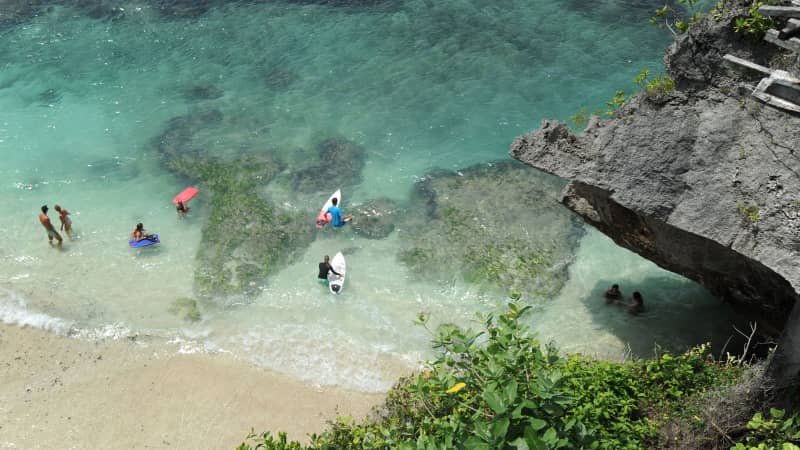
At least 6.3 million people visited Bali in 2019.
SONNY TUMBELAKA/AFP via Getty Images
Bali has also been successful in containing its coronavirus outbreak, with less than 350 confirmed cases and, at the time of writing, a total of four deaths.
The Indonesian island now hopes to welcome tourists back by October, provided its infection rates stay low.
Bali’s economy is hugely dependent on tourism and visitor numbers have been rising in recent years, with around 6.3 million people visiting in 2019.
All foreign nationals, except for diplomats, permanent residents and humanitarian workers, are currently banned from Indonesia, and anyone entering the island must undergo a swab test and provide a letter stating they are free of Covid-19.
It’s unclear what the entry requirements will be if restrictions are lifted later this year, or whether Bali will accept travelers from regions badly affected by the pandemic.
Thailand
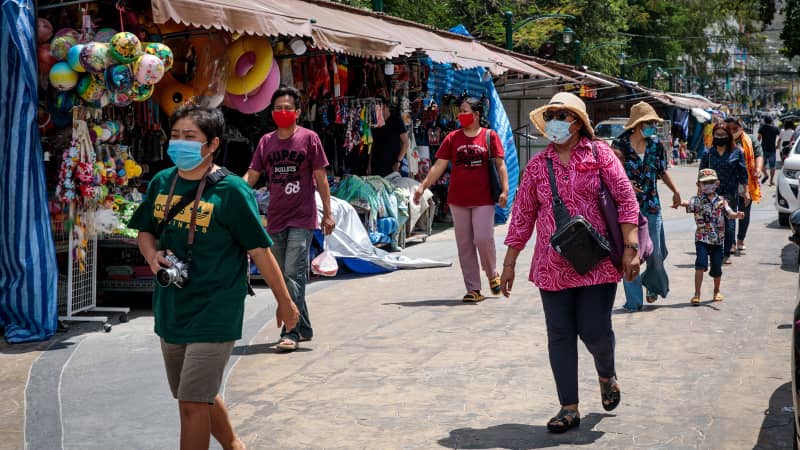
Thailand plans to reopen different regions stage by stage towards the end of 2020.
JACK TAYLOR/AFP via Getty Images
Thailand has long been among the top destinations for travelers, receiving close to 40 million foreign tourists last year.
However, visitors have been banned from entering the Southeast Asian country since March because of the pandemic.
While the number of cases here has been relatively low in comparison to other destinations — Thailand has reported more than 3,000 confirmed cases and over 50 deaths — officials aren’t taking any chances when it comes to reopening the country.
The governor went on to stress there will be limitations on who can visit the country and what regions they can go to once restrictions are relaxed.
“We are not going to open all at once,” he added. “We are still on high alert, we just can’t let our guards down yet.
“We have to look at the country of origin [of the travelers] to see if their situation has truly improved.”
This effectively means Thailand is unlikely to open its borders to travelers from destinations that don’t appear to have the coronavirus situation under control.
Those that are given permission to enter may be offered “long-stay packages” in isolated areas “where health monitoring can be easily controlled,” such as the remote islands of Koh Pha Ngan and Koh Samui.
However, Thailand’s borders are firmly shut for the time being.
Like many other global destinations, Thailand is currently focusing on domestic tourism.
In fact, some resorts and hotels have already been given the go ahead to reopen — Hua Hin, located about 200 kilometers (124 miles) south of Bangkok, being one of them.
Shopping malls, museums, markets and some tourist attractions have also been reopening their doors, with Bangkok’s Grand Palace due to reopen on June 4.
France

Residents of France will be allowed to take holidays within the country during July and August.
DAMIEN MEYER/AFP via Getty Images
France was the most visited country in the world before the coronavirus pandemic.
Now, like the rest of the EU, restrictions are currently in place on all nonessential travel from outside the Schengen Zone (a grouping of 26 countries which normally have open borders).
Travelers who do enter the country, with the exception of EU citizens or arrivals from the UK, will be subject to a compulsory 14-day coronavirus quarantine until at least July 24.
“Since the start of the crisis, the closure of the borders is the rule, and the authorization to cross a border is the exception.
“What is good for tourism is often good for France, what strikes tourism strikes France,” he said during a news conference.
Although some businesses have been given permission to reopen, the country’s hotels, bars, restaurants and cafés are to remain closed at least until June 2.
Even then, it’s unlikely establishments in Paris, which has been marked as a coronavirus “red zone” by officials, will be allowed to open any time soon.
It was announced on May 29 that the country’s most visited museum, the Louvre, will reopen July 6.
“Tourism is facing what is probably its worst challenge in modern history,” added Philippe. “Because this is one of the crown jewels of the French economy, rescuing it is a national priority.”
He went on to state that residents can take holidays within France during July and August.
The country’s hotels will be reliant on domestic tourism once they do reopen, as all signs suggest international travelers will not be able to enter for the foreseeable future.
“When the lockdown measures soften, French tourists are likely to want to stay close to home in the short term,” a spokesperson for French hotel chain Accor told CNN Travel earlier this month.
“It will be the moment for them to rediscover their own country and we will be there to welcome them.”
Greece

Officials in Greece are hoping to reopen the country on June 15.
cunfek/Getty Images
Tourism accounts for almost 20% of Greece’s gross domestic product, as well as one in five jobs, so it’s perhaps no surprise the Mediterranean nation is angling to reopen to tourists as soon as it possibly can.
The European country, which managed to keep its coronavirus case numbers low by implementing a strict lockdown early on, plans to allow travelers back in on June 15.
“The tourism period begins on June 15, when seasonal hotels can reopen,” Prime Minister Kyriakos Mitsotakis announced on May 20.
“Let us make this summer the epilogue of the [Covid-19] crisis,” he added.
Mitsotakis went on to state that direct international flights to Greek destinations will slowly resume from July 1, and tourists will no longer be expected to take a Covid-19 test or go into quarantine on arrival.
However, Tourism Minister Haris Theoharis has indicated health officials will conduct spot tests when necessary.
“Maybe no bars may be open, or no tight crowds, but you can still get a fantastic experience in Greece — provided that the global epidemic is on a downward path.”
Bars and restaurants have also been allowed to take up business again, while city hotels are scheduled to reopen on June 1, followed by seasonal hotels in July.
All international passengers had previously been required to take a Covid-19 test upon arrival or go into quarantine for 14 days.
Mitsotakis had suggested tourists would be required to undergo testing before their visit as a further precaution in the future, but it seems this is no longer the case.
Germany
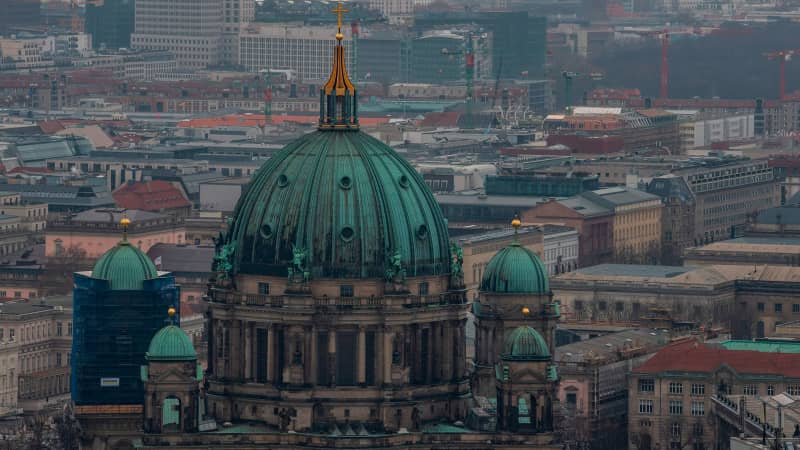
Restrictions in Germany are being gently relaxed as the country prepares to revive its tourism industry.
JOHN MACDOUGALL/AFP via Getty Images
Officials are also considering allowing entry to visitors from Turkey, the UK, Iceland, Liechtenstein, Norway and Switzerland, although a final decision is yet to be made.
“The revitalization of tourism is important both for travelers and the German travel industry, as well as for the economic stability of the respective target countries,” it reads.
The Austria/Germany land border is also reopening — travel between Austria and Germany will be possible from June 15 — and restrictions around the country are being relaxed.
Mexico
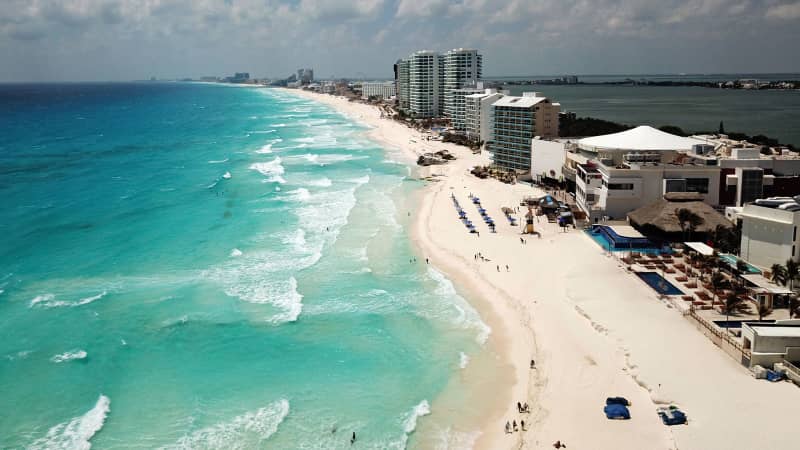
Over the coming weeks, Mexico will begin to open up region by region.
ELIZABETH RUIZ/AFP via Getty Images
Mexico is aiming to welcome visitors back within weeks.
While the nation remains in lockdown, with hotels and restaurants yet to recommence business, officials are planning to reopen the country bit by bit in order to get things back on track.
“The target is domestic travelers first, followed by travelers from the US and Canada and then the rest of the world.
The border between the US and Mexico border is closed to “nonessential” travel until at least June 22 and most international flights in and out of Mexico’s key airports are currently suspended or significantly reduced.
However, Delta Air Lines will be increasing and/or resuming various services from the US to Cancun, Mexico City Los Cabos and Puerta Vallarta in the coming weeks.
Quintana Roo, a state on the Caribbean side of Mexico that’s home to the likes of Cancun, Playa del Carmen and Tulum, hopes to reopen in mid-June, according to Marisol Vanegas, the state’s tourism secretary.
“We want to revive tourism and expect to start opening sights and hotels sometime between June 10 and 15 but don’t know which ones yet,” she says.
“It depends on what the federal government allows us to do.”
Rodrigo Esponda, managing director of the Los Cabos Tourism Board, says he hopes to be able to accept both international and domestic travelers by August and September.
However, beach destination Riviera Nayarit, situated north of Puerta Vallarta, currently has no immediate plans to bring back tourists, according to Richard Zarkin, the public relations manager for the Riviera Nayarit Convention and Visitors Bureau.
Turkey
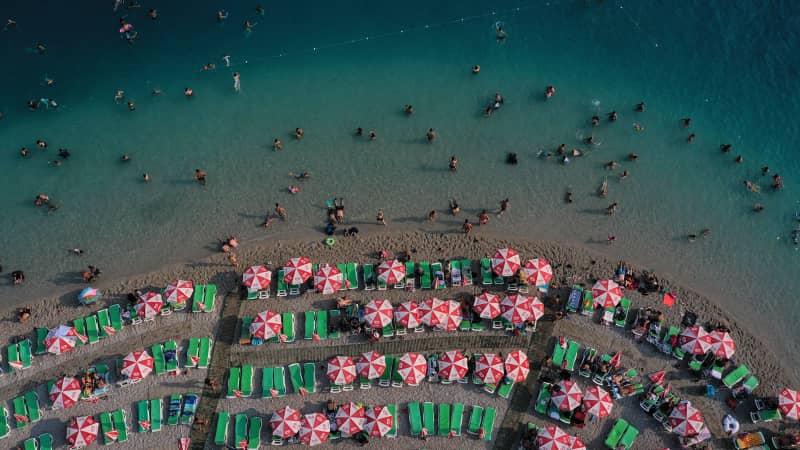
Turkey is aiming to receive international visitors from mid-June.
Burak Kara/Getty Images
Turkey made over $34.5 billion from tourism in 2019, and the transcontinental country is eager to get back in business.
According to Tourism Minister Mehmet Nuri Ersoy, the destination plans to restart domestic tourism by the close of May and hopes to receive international visitors from mid-June.
The country has set out new guidelines for its hotels and resort facilities, such as temperature checks at entrances and at least 12 hours of room ventilation after checkout. Guests will be required to wear face masks and maintain social distancing.
Meanwhile, restrictions on intercity travel have been lifted, while restaurants, cafes, parks and sports facilities are permitted to reopen from June 1, along with beaches and museums.
Italy
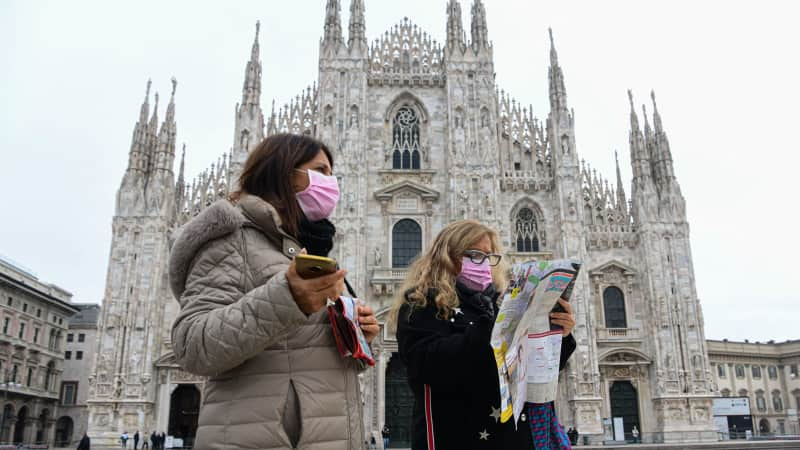
Italy is dropping its compulsory quarantine for arrivals in a “calculated risk” to entice tourists back.
PIERO CRUCIATTI/AFP via Getty Images
Italy has been one of the destinations worst hit by the pandemic, but the hugely popular European country is keen to get its tourism industry up and running now that infection rates have slowed down.
Travelers from the EU, along with the UK and the microstates and principalities of Andorra, Monaco, San Marino and the Vatican, will be allowed to enter without having to go into quarantine starting June 3, in a move the government has described as a “calculated risk.”
“We have to accept it; otherwise, we will never be able to start up again.”
Visitors were previously required to undergo a two-week quarantine before being allowed entry.
Spain
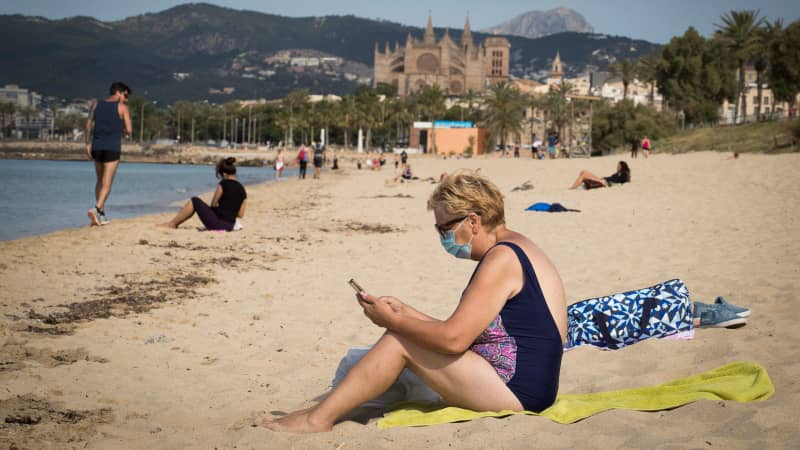
At least 84 million people visited Spain in 2019.
JAIME REINA/AFP via Getty Images
Spain’s lockdown was one of the toughest in Europe, but restrictions are gently being lifted. Beaches set to reopen in June while hotels in some parts of the country have already been permitted to resume business.
From July 1, the European destination, which welcomed a record 84 million visitors in 2019, will grant EU travelers permission to enter without having to quarantine for two weeks.
“Come July, we will allow the arrival of foreign tourists to Spain under safe conditions,” Prime Minister Pedro Sánchez said at a recent news conference.
“We will guarantee that tourists are not at risk, and that they don’t represent a risk (to Spain).”
While there’s been little mention of opening borders to travelers beyond the EU, it’s thought Spain is hoping to follow the lead of destinations such as Lithuania and the Czech Republic by establishing safe corridors, or a “travel bubble,” with nearby destinations that have managed to keep the outbreak under control.
“The issue of borders will be accompanied by the evolution of the health crisis.”
At present, it’s mandatory for anyone 6 and older to wear face masks while in public, both indoors and outdoors, “where it is not possible to maintain [an interpersonal] distance.”
The Maldives
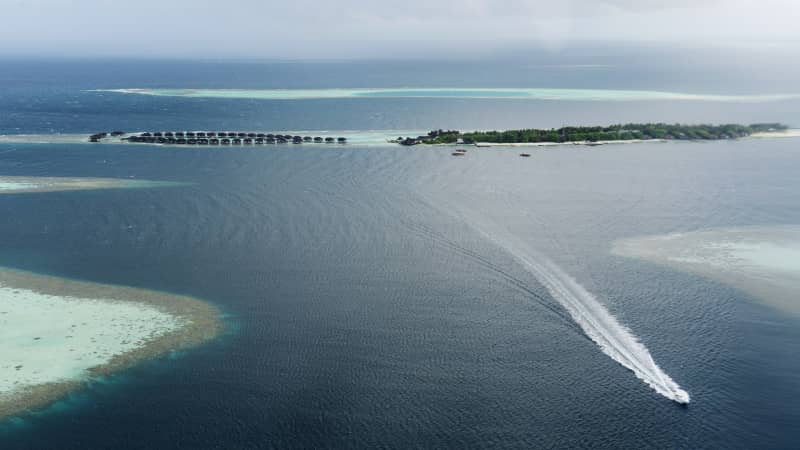
Private jets and super yachts will be permitted to enter the Maldives from June 1.
ROBERTO SCHMIDT/AFP/AFP/Getty Images
It’s already one of the most lavish destinations in the world, but the Maldives looks set to become even more exclusive once it reopens.
The island nation, made up of over 1,000 islands, closed its national borders and canceled all flights shortly after recording its first two coronavirus cases in March.
The Maldives has recorded around 1,457 confirmed cases and five deaths from Covid-19 so far.
While it was previously thought the destination would reopen at the end of the year, officials have brought this forward to July.
However, a previously reported $50,000 landing fee for charter flights and private jets has been removed, along with a suggested tourist visa fee.
“We are planning to reopen our borders for visitors in July, 2020,” reads an official statement issued by the Ministry of Tourism on May 30.
“We also want to assure our guests that they will not be charged any additional fees to enter the Maldives.”
Travelers who make the trip over will need to have a confirmed booking with a tourist facility with a “Safe Tourism License,” as well as a special tourist visa available to those committed to spending a minimum of 14 days in the country.
Visitors will also need to present a valid medical certificate confirming they are Covid-19 free.
The Maldives received more than 1.7 million visitors in 2019 and the destination had expected numbers to rise to two million in 2020.
St. Lucia
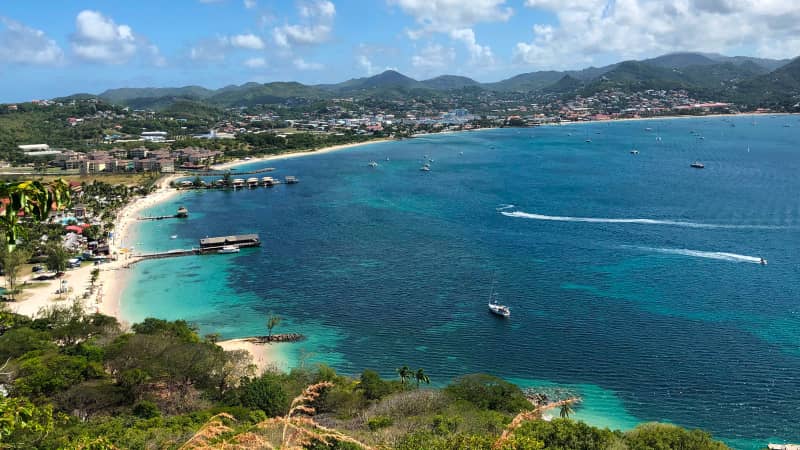
St. Lucia will begin its phased reopening on June 4.
DANIEL SLIM/AFP via Getty Images
St. Lucia is one of several Caribbean islands trying for a tourism comeback.
Those traveling to the country must present “certified proof” of a negative Covid-19 test taken within 48 hours of boarding their flight.
Visitors will also be subject to screening and temperature checks by port health authorities and must wear face masks and maintain social distancing during their visit.
Officials are also bringing in new safety measures for taxis to separate drivers and passengers.
“The government of Saint Lucia remains resolved to protect both lives and livelihoods as it jump starts its economy.”
Local businesses have also been allowed to reopen, provided they have appropriate cleaning measures and social distancing measures in place.
Details of the second phase of the island’s reopening, which is to begin on August 1, will be announced in the coming weeks.
Portugal
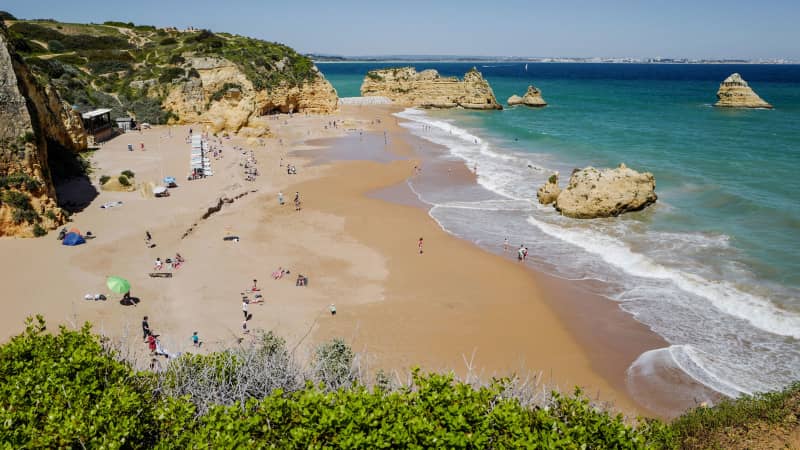
Foreign Minister Augusto Santos Silva recently declared that Portugal is open and “tourists are welcome.”
LUDOVIC MARIN/AFP via Getty Images
Portugal is still in the process of relaxing lockdown restrictions, allowing restaurants, museums and coffee shops to reopen at reduced capacity from mid-May.
But the European country is keen to revive its struggling tourism industry, with Foreign Minister Augusto Santos Silva recently declaring “tourists are welcome.”
While visitors from outside the EU are banned until at least June 15, some routes in and out of Portuguese-speaking nations such as Brazil are still operating.
The land border between Portugal and Spain, which has been closed to tourists since March, is unlikely to reopen until EU travel restrictions are lifted.
“We are gradually going to start looking at easing border controls,” Internal Affairs Minister Eduardo Cabrita said earlier this month.
Although the prospect of reopening to international tourists appears to be a little while off, officials are putting measures in place to ensure foreign travelers will feel confident to return once they’re able to.
This is valid for all bookings made through accredited travel agencies, along with hotels or Airbnbs, for trips scheduled between March 13 and September 30, 2020.
Businesses will have to comply with hygiene and cleaning requirements for the prevention and control of Covid-19 to receive the stamp, which is valid for one year.
According to Santos Silva, Portugal’s airports will soon be introducing health checks for arrivals, but visitors will not be subject to a mandatory quarantine.
Aruba
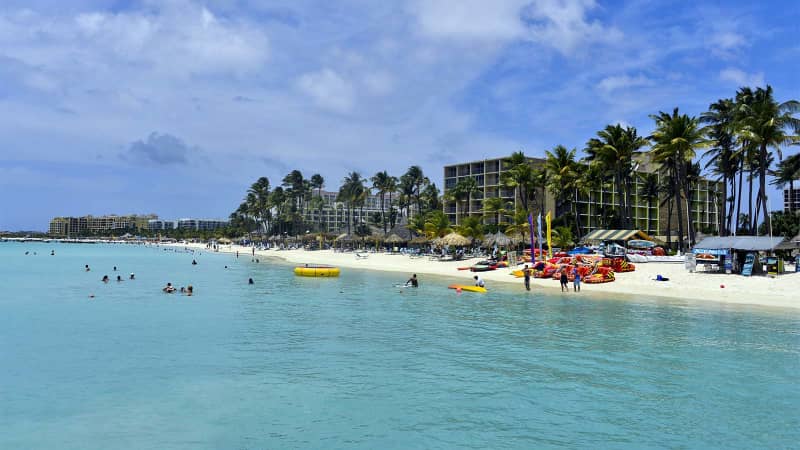
Aruba has issued “tentative” reopening dates, which fall between June 15 and July 1.
LUIS ACOSTA/AFP/Getty Images
However, the visitor’s bureau for the Caribbean island, which has reported just over 100 confirmed coronavirus cases, says this “tentative” date may change if Aruba opts to “consider additional precautionary measures as needed.”
Although there’s no mention of any Covid-19 testing requirements for arrivals, tourists will be required to undergo temperature checks on arrival.
While nonessential businesses including shopping malls, cinemas, beauty salons and outdoor restaurants were allowed to reopen on May 25, the island country’s 10 p.m. to 5 a.m. curfew remains in place.
This means such establishments are required to close by 10 p.m. every day.
Georgia
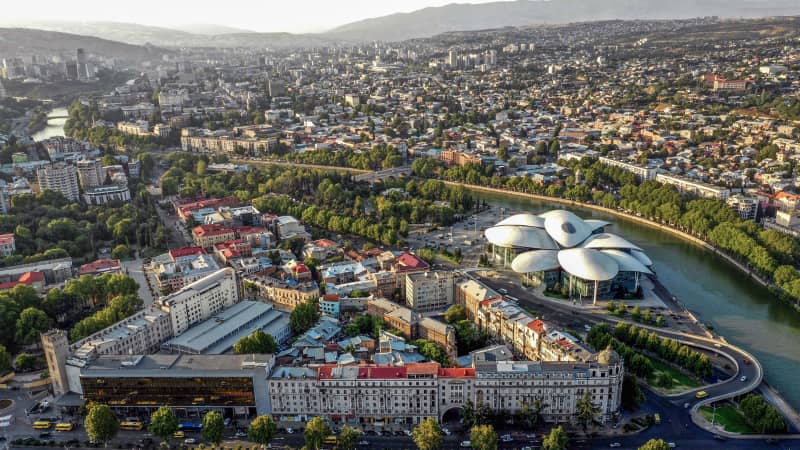
Georgia aims to welcome back international travelers from July 1.
VANO SHLAMOV/AFP via Getty Images
But the country was forced to close its winter resorts and place a ban on all foreign visitors back in March because of the crisis.
Eager to revive its tourism sector, the country’s government says it plans to reopen to international travelers on July 1.
The next stage will allow for domestic travel in special “safe” tourism zones, while the final stage involves reopening borders and resuming some flights.
“[The] tourism sector will be first to which emergency relief measures will apply.”
United Kingdom

A mandatory 14-day quarantine has been issued for all arrivals to the UK from June 8.
Maja Hitij/Getty Images
While other destinations are relaxing travel restrictions and bringing in measures to lure travelers back, the UK is choosing to enact stricter regulations.
Under the new rules, all arrivals will have to provide an address, at which they must remain for two weeks.
Those who break the rules will be subject to fines of up to $1,218.
The decision, which is to be reviewed every three weeks, has quashed any hopes of rescuing international tourism here in the coming weeks.
It’s thought the move may discourage airlines from restarting flight operations swiftly, while officials have warned there’s little chance of UK residents being able to go abroad this summer.
“I’m saying, right now you can’t travel abroad,” Transport Minister Grant Shapps said during a BBC television interview when asked whether UK citizens should book flights in July.
“If you are booking it, you are clearly by very nature taking a chance of where the direction of this virus goes and therefore where the travel advice is in the future.”
At present, hotels are primed to open in early July, but as EU border restrictions are still in place, it’s likely the UK will be focusing on domestic travel for now.
“We’re still awaiting further clarity from the government on when the hotel can reopen, but we have been working behind the scenes to adapt our operations to ensure extra safety for both our staff and guests when we do,” a spokesperson from the Surrey hotel told CNN Travel earlier this month.
“All visitors and staff will be required to submit a temperature check on arrival and be asked to sanitize their hands when entering all buildings on the estate.
CNN’s Kocha Olarn, Karla Cripps, Shivani Vora and Elinda Labropoulou also contributed to this article.
